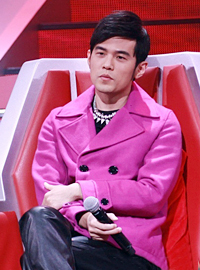:想变得更加吸引人么?好好阅读下这篇文章你就能实现了!不过文章有些深奥哦……

I’m going around the world giving talks about Darwin, and usually what I’m talking about is Darwin’s strange inversion of reasoning. Now that title, that phrase, comes from a critic, an early critic, and this is a passage that I just love, and would like to read for you.
我经常在世界各地做关于达尔文的演讲,一般我都要讲到的是达尔文奇怪的“反向逻辑”。 这个“头衔”,这个名词,来自于一个批评,一个早先的批评。我喜欢这篇文章,很乐意给大家念一下。
In the theory with which we have to deal, Absolute Ignorance is the artificer; so that we may enunciate as the fundamental principle of the whole system, that, in order to make a perfect and beautiful machine, it is not requisite to know how to make it. This proposition will be found on careful examination to express, in condensed form, the essential purport of the Theory, and to express in a few words all Mr. Darwin’s meaning; who, by a strange inversion of reasoning, seems to think Absolute Ignorance fully qualified to take the place of Absolute Wisdom in the achievements of creative skill.
这个我们要探讨的理论之中,“全然无知”变成了创造者;那么让我们清楚阐明这个理论体系的根本原则,那就是,在制造一个完美的机器之前,完全没有必要知道如何来制造它。这种说法被建立在详尽的研究之上来传达这个理论的要义,也传达了达尔文先生的全部意思;他用这样一种奇怪的“反向逻辑”似乎认为“绝对的无知”完全有资格取代“绝对的智慧”来完成需要创造性技能的工作。
Exactly. Exactly. And it is a strange inversion. A creationist pamphlet has this wonderful page in it:"Test Two: Do you know of any building that didn’t have a builder? Yes/No. Do you know of any painting that didn’t have a painter? Yes/No. Do you know of any car that didn’t have a maker? Yes/No. If you answered ’Yes’ for any of the above, give details."
可不是嘛!可不是嘛!这真是一个奇怪的“反向”。一位上帝论者的小册子上有这样一页非常精彩:测验二你知道任何一栋建筑没有它的建设者?有,没有。你知道有任何一副画没有它的绘画者?有,没有。你知道有任何一辆小汽车没有它的制造者么?有,没有。如果你在任一问题中答“有”,给出其细节。
A-ha! I mean, it really is a strange inversion of reasoning. You would have thought it stands to reasonthat design requires an intelligent designer. But Darwin shows that it’s just false.
啊哈!我说,这可真是一个奇怪的“反向逻辑”啊!你可能觉得这种说法站得住脚:那就是但凡设计都需要一个智慧的设计者。可达尔文证明,那是错误的。
Today, though, I’m going to talk about Darwin’s other strange inversion, which is equally puzzling at first, but in some ways just as important. It stands to reason that we love chocolate cake because it is sweet. Guys go for girls like this because they are sexy. We adore babies because they’re so cute.And, of course, we are amused by jokes because they are funny.
但是今天,我要谈的是达尔文的另一个奇怪的“反向逻辑”。它乍眼看来也是一样莫名其妙,但从某种程度上说,它也是一样重要。说我们喜欢巧克力是因为它很甜,似乎说得过去。 小伙子们迷这样的姑娘,因为她们很性感。我们宠爱这样的婴儿,因为他们是那么可爱。当然,我们还喜欢笑话,因为它们搞笑。
This is all backwards. It is. And Darwin shows us why. Let’s start with sweet. Our sweet tooth is basically an evolved sugar detector, because sugar is high energy, and it’s just been wired up to the preferer, to put it very crudely, and that’s why we like sugar. Honey is sweet because we like it, not "we like it because honey is sweet." There’s nothing intrinsically sweet about honey. If you looked at glucose molecules till you were blind, you wouldn’t see why they tasted sweet. You have to look in our brains to understand why they’re sweet. So if you think first there was sweetness, and then we evolved to like sweetness, you’ve got it backwards; that’s just wrong. It’s the other way round.Sweetness was born with the wiring which evolved.
但这都是倒因为果的逻辑。达尔文会告诉我们为什么。从甜开始吧,我们馋甜的,其实是一种进化出来的糖探测器。因为糖是高热量的,所以它就被大脑强化为我们的一项偏爱。简单来讲,这就是为什么我们喜欢糖。蜜是甜的,因为我们喜欢它,而不是“我们喜欢蜜,因为它是甜的。”蜂蜜内在没有任何所谓的甜。哪怕我们盯着葡萄糖,看到双眼失明,我们也没法看出来为什么它们是甜的。你必须要从我们大脑中来理解为什么它们甜。所以如果你认为首先有了甜, 然后我们进化成了喜欢甜,那你就搞反了:这是错的。应该是倒过来。甜的出现是和大脑里那个沟回的进化一起发生的。
And there’s nothing intrinsically sexy about these young ladies. And it’s a good thing that there isn’t, because if there were, then Mother Nature would have a problem: How on earth do you get chimps to mate? Now you might think, ah, there’s a solution: hallucinations. That would be one way of doing it, but there’s a quicker way. Just wire the chimps up to love that look, and apparently they do. That’s all there is to it. Over six million years, we and the chimps evolved our different ways. We became bald-bodied, oddly enough; for one reason or another, they didn’t. If we hadn’t, then probably this would be the height of sexiness.
这些年轻小姐们也没有什么内在的性感。而且没有是件好事,因为假如真的有了,我们的自然之母就要有麻烦了:我可怎么让这些猩猩们交配啊?现在你也许在想。啊哈!我有一招:性幻想!这也许是个办法,但还有一招更快。就是让猩猩们的大脑产生个沟回,爱上那个样子。而且显然,它们爱上了。就是这么回事。过了六百万年,我们和猩猩进化成了不同的样子。我们变得身躯无毛,有够奇怪的;而由于某种原因,它们没有 如果我们也没有的话,那么可能这个就变成了绝顶性感了。
Our sweet tooth is an evolved and instinctual preference for high-energy food. It wasn’t designed for chocolate cake. Chocolate cake is a supernormal stimulus. The term is owed to Niko Tinbergen, who did his famous experiments with gulls, where he found that that orange spot on the gull’s beak - if he made a bigger, oranger spot the gull chicks would peck at it even harder. It was a hyperstimulus for them, and they loved it. What we see with, say, chocolate cake is it’s a supernormal stimulus to tweak our design wiring. And there are lots of supernormal stimuli; chocolate cake is one. There’s lots of supernormal stimuli for sexiness.
我们馋甜东西是一种进化出来的内在偏爱,偏爱高热量食物。那不是针对巧克力蛋糕而设计的。巧克力蛋糕是一个超常刺激。这个词是尼古拉斯.丁伯根提出来的。他做了他出名的海鸥实验 他发现了海鸥喙上的橘点,如果他把这个点放大,染得更橘,那么小海鸥就会更猛烈地啄它。这对它们来说是兴奋的刺激,它们狂爱这个。对于我们而言,比方说,巧克力蛋糕,就是一个超常刺激,它扭曲了我们脑内沟回的本意。有很多很多的超常刺激,巧克力蛋糕是一个。 有很多对于性感的超常刺激。
And there’s even supernormal stimuli for cuteness. Here’s a pretty good example. It’s important that we love babies, and that we not be put off by, say, messy diapers. So babies have to attract our affection and our nurturing, and they do. And, by the way, a recent study shows that mothers prefer the smell of the dirty diapers of their own baby. So nature works on many levels here. But now, if babies didn’t look the way they do - if babies looked like this, that’s what we would find adorable, that’s what we would find - we would think, oh my goodness, do I ever want to hug that. This is the strange inversion.
甚至有对于可爱的超常刺激,这就有一个很好的例子。喜欢婴儿对于我们来讲很重要,这样我们就不会因为某些麻烦-比如说脏尿布-而嫌弃他们。因此婴儿必须要吸引我们的爱意和抚养,他们确实做到了。另外顺便说一句,最近一个研究表明 妈妈们都更喜欢闻自己孩子的脏尿布。可见自然在不同的层次上起着作用。但现在,如果婴儿们不再像他们现在的样子,而是看上去这样。这就是我们觉得可爱的样子,这就会使我们想“哦,天哪!我可真想抱抱啊!” 这是一个奇怪的“反向逻辑”
Well now, finally what about funny. My answer is, it’s the same story, the same story. This is the hard one, the one that isn’t obvious. That’s why I leave it to the end. And I won’t be able to say too much about it. But you have to think evolutionarily, you have to think, what hard job that has to be done -it’s dirty work, somebody’s got to do it - is so important to give us such a powerful, inbuilt reward for it when we succeed. Now, I think we’ve found the answer - I and a few of my colleagues. It’s a neural system that’s wired up to reward the brain for doing a grubby clerical job. Our bumper sticker for this view is that this is the joy of debugging. Now I’m not going to have time to spell it all out, but I’ll just say that only some kinds of debugging get the reward. And what we’re doing is we’re using humor as a sort of neuroscientific probe by switching humor on and off, by turning the knob on a joke - now it’s not funny ... oh, now it’s funnier ... now we’ll turn a little bit more ... now it’s not funny-in this way, we can actually learn something about the architecture of the brain, the functional architecture of the brain.
那么现在,最后关于可笑。我的答案是,一样的故事,是个一样的故事。这个比较难懂,不太显而易见,所以我把它留到最后。 而且我今天也不会讲太多这个。你必须从进化的角度来想,你得想,什么困难的活必须被完成-这是一个脏活,而且必须有人来完成它-以至于当我们完成的时候,给我们一个强烈的内在奖励那么重要。现在,我想我们有答案了,我和几位我的同事。这是一种为了奖励大脑完成了某项 肮脏的事务性工作而产生的神经反应体系。我们关于这个观点的招牌说法就是 这是排除故障的快感。现在我没时间来把这个展开讲了,但我得说,只有某几种“排除故障”能够获得这种快感。我们现在所做的,就是把幽默感作为一种神经科学的探针,通过幽默的开关,通过调整笑话-“这个不搞笑了……哦,现在这个有意思……”“现在我们调整一点……现在又不搞笑了”-通过这种方式,我们事实上能学到 一些关于大脑构造的知识, 关于大脑的功能性构造。
Matthew Hurley is the first author of this. We call it the Hurley Model. He’s a computer scientist, Reginald Adams a psychologist, and there I am, and we’re putting this together into a book. Thank you very much.
马修.赫尔利是这本书的第一作者,我们称这个为赫尔利模型。他是个计算机科学家,雷金纳德.亚当斯一位心理学家,然后就是我。我们正在把这些写进一本书里。谢谢大家!






































































































